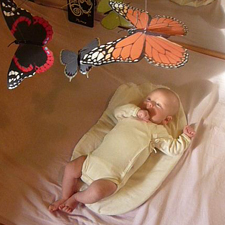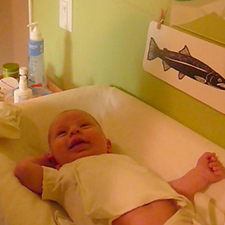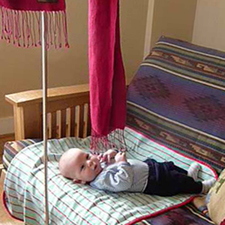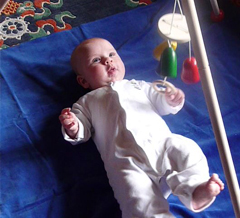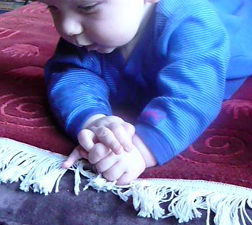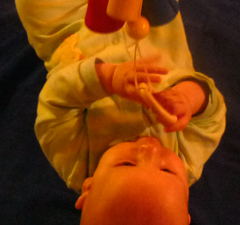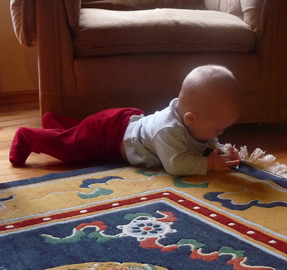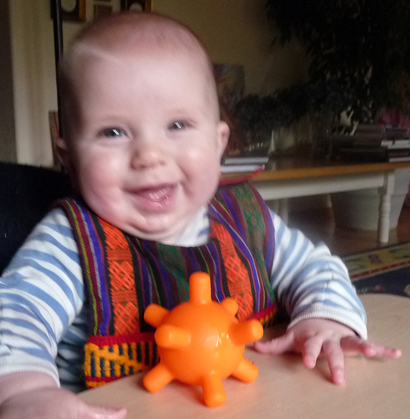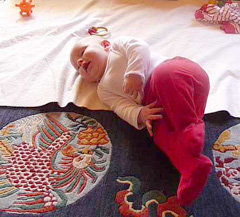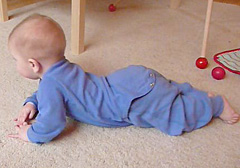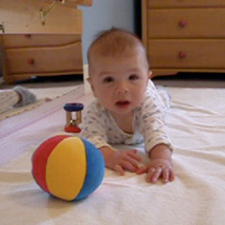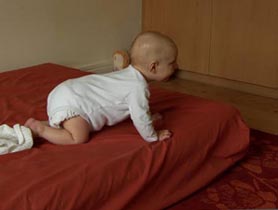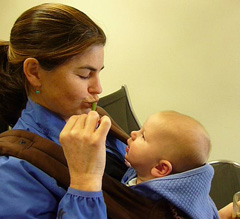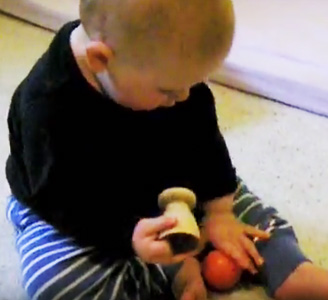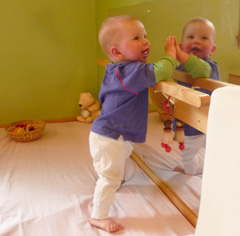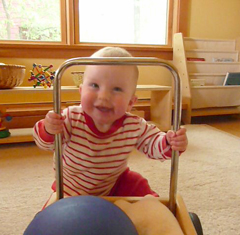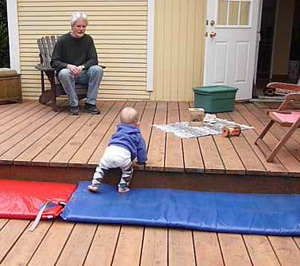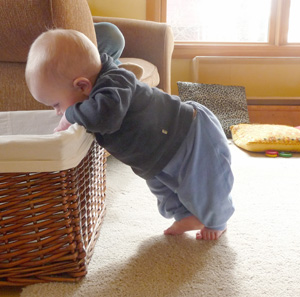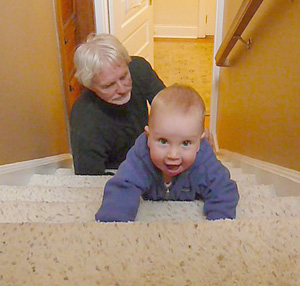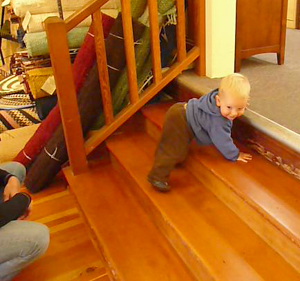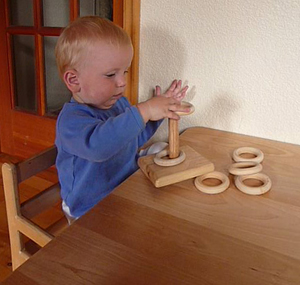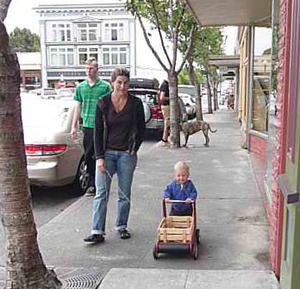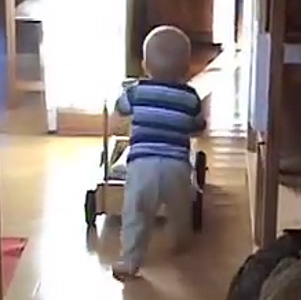Montessori Child Development Stages:
|
|||||
| Age 0-3 home page: birth-three
Age 0-1 page: first year Age 1-2 page: second year Age 2-3 page: third year Ages and stages are different from child to child, each person unique. Our role is to prepare the environment, study the child, give clear lessons, step back and support exploration and concentration, and then to observe the miracle of concentration on self-chosen activities and the resulting happiness and compassion toward others. Middle School Human Development Course |
All of our staff watched the clips and were truly touched by them; I can hardly find words to describe the wonders of seeing a small baby having such a productive communication with his mother. Studying your website and catalogs helped me shape my understanding of the 0-3 approach and curriculum. I am continually enthralled by the videos you post on your website. The international students on the 0-3 and 0-6 courses and parents I encounter continually oooh and ahhh over them and are amazed at the concentration, the independence, the abilities of such tiny children. Thank you for your continued work for the child under three. |
||||
NOTE After watching the videos on this page on the YouTube channel, you will be directed, by YouTube (trying to be helpful) to a random series of videos that have nothing to do with this site, and that we do not recommend, Filling a home with expensive toys is not necessary. Children want to carry out activities that they see the other family members doing. In the Montessori 0-3 infant community they see other children playing with the special early Montessori materials so they want to imitate, but in the home, the best thing parents can do is to make a space in every room of the home, a low and safe shelf and cupboard, and place everyday household items there. Then young children will feel like they are participating with the work of the family. |
|||||
| SLEEP-WAKE-EAT: While in the womb a child sleeps and wakes up according to his needs. He is born with the ability to self-regulate both sleeping and eating and we can support this ability by observing him carefully. It is important that he be fed on-demand rather than on a schedule (even though the intervals will be very close together in the first days) and that the parents do not wake him when sleeping, or try to 'put' him to sleep, letting him go to sleep and wake up on his own. Gradually he will adjust to the family schedule. If provided a place in a bedroom and also in the areas where the family spends the day he will learn to put himself to sleep, and to wake up on his own, no matter what is going on around him. | MOVE-WORK: The child is born ready to explore his environment with all of his senses, so we should see that the environment is interesting but not over-stimulating (by sights and sounds), and that his body is free to move from the very first day—no swaddling please!. He should not be overdressed, or his hands and feet covered, and he should have mobiles to look at and soon items to reach for and touch. A floor bed in a safe room goes a long way to help with both visual exploration and movement development. It is often thought that children only eat and sleep in the first weeks, but this is not true! Children often cry from boredom! So let us play particular attention to what he can see, hear, and do even in those early days and weeks | ||||
|
|
||||
In the first days and months of life the child is intensely interested in watching and looking. At first his ability to focus is the distance between his eyes and the mother's face during nursing. Soon he is interested in watching mobiles that move gently in the wind. Mobiles should have no more than 5 objects and they should be real, such as butterflies, birds, or fish—things that move through the air or water. (2.5 months) |
When the older children and adults exactly mimic the baby's first attempts at making verbal sounds, a beautiful conversation, or song, can occur. Here the mother and baby are talking/singing to each other at the changing table. Using the kind of pacifier or gum soother that stays in the mouth and does not have to be held there, can cause an addiction and prevent this wonderful stage of human communication from occurring. (2.5 months) |
||||
|
|
||||
| The This baby was visiting a home where there were no visual mobiles and he needed to carry out this important daily "work". So the mother hung a scarf over a lampshade in front of an open window, creating a moving object for the baby to focus on. Suddenly she realized that it seemed he was ready to move beyond watching, to touch! He tried with his whole body to reach the fringe of the scarf, but is not yet at the stage of controlling his hands to this extent. (2.5 months) | At first the baby was able to kick or reach for the mobile only, but gradually learned how to grasp the wooden ring at the bottom and to shake it, making a kind of first music with the lovely sound of the wooden chimes. His excitement shows with the whole body as he experiments—moving, the sound happens, holding still the sound stop—over and over. This is valuable research and should not be interrupted. |
||||
|
|
||||
When a mother or father speaks to a child kindly, with correct language and in a normal tone of voice (not using baby talk), and explains what she/he is doing (in this case buttoning a sweater) the child intuitively knows he is being respected a a fully conscious human being. At the same time he is absorbing a wealth of language—during the time when he is focused intently on language in preparing for later speech and writing. "I am buttoning your sweater" or "One button, two buttons, three buttons," NOT "Mommy is dressing baby.") This is very important work. Age 5 months. |
In the early weeks a child can lift his head, but needs daily "tummy" time from birth on, several times a day, in order to fully develop his whole body, his hand, and his naturally curious mind in all ways. This is very important work. Age 4 months. |
||||
|
|
||||
Each stage of learning to use the hand is important work for the child. Here the "work" is concentrating on holding an object with one hand, then grasping it with the second hand, and then letting go with the first hand. Then the reverse and repeat, and repeat. When not interrupted a child will work on this hand transfer for a long time. Until he is finished for now. |
The child was looking around, exploring the environment visually, and suddenly the music began to play. He held very still, looking in the direction of the music, the CD player. Recognizing the intensity of the child's focus, the mother sat just as still for a long time, until the child showed her—by turning his head, sighing with satisfaction, and again focusing on the environment, that he had finished listening to the music. | ||||
|
|
||||
This child is being provided with valuable "tummy" time with is important for developing neck and upper body muscles and preparing for crawling with is vital for brain development. He is exploring "rough" (the carpet), "smooth" (the wood floor), and manipulating the carpet fringe with his hands. This is very important work. Age 5 months. |
Children should learn, as early in life as possible, that music comes from a real human's actions; this child's eyes move back and forth from the drummer foot and hand, the two sources of sound. Parents should singing every day (No one has to be a Bonnie Raitt), and whenever possible provide exposure to real instruments being played. This gives the child the real world in all its musical possibilities and provides a model for his future. This is very important work. Age 5 months. |
||||
|
|||||
This "perfect pacifier" is far superior to the kind of fooler or pacifier that stays in a child's mouth for long periods of time, with the potential interruption of language development and physical development of teeth and gums, not to mention the risk of creating a habit of creating happiness from oral stimulation (overeating or drinking, smoking, etc.). This "tool" has just come back into production and will soon be available from the Michael Olaf Montessori Company. www.michaelolaf.net |
At first the child turns over accidentally and often to his great surprise, but eventually each child learns how to turn over intentionally and to do so with great joy and anticipation. Now he will be able to balance his own exercise routine, on back and on tummy. This is another reason whey the child must be kept o a flat surface for most of the day in a safe environment. this is important work. |
||||
|
|
||||
For months a child has been exploring the environment visually and can hardly wait to taste and touch! The drive to move forward in any way possible also builds a healthy brain; "creeping" and crawling prepare for reading and writing and thinking. the best thing we an offer the child at this safe is a safe and interesting environment and freedom to move without being rushed or interrupted. This is very important work. (4-5 months) NOTE: Some people reverse the terms "creeping" and "crawling." |
Children all over the world exhibit the same stages of development when they have an environment that supports them. A mattress on the floor, freedom to move and explore in a very safe place. This little Polish boy shows us the whole body rocking stage that precedes crawling, the balance and confidence to develop the abilities to get off of his floor bed, and no doubt the excitement to move from the bedroom to the wider world of the home. NOTE: Some people reverse the terms "creeping" and "crawling." |
||||
|
|
||||
From the moment of birth children are watching us, from the first inspection of the mother's face during nursing, to the way we stand and walk and talk and treat each other. We are their models by our actions, not by what we think we are teaching them intentionally, but by how we really are. Seeing another person, adult or child, standing up and walking, chewing food, using the bathroom, washing hands, reading—these are the things that inspire the very young child to work hard to do the same. |
As soon as the child can sit up the hands are freed for important work and we should provide for this need. Over many years of the Montessori Assistants to Infancy work around the globe materials, made of natural products instead of plastic, have been developed that charm the child and at the same time provide a motive for concentration, problem solving, and the repetition of movements of the hand and arm and whole body that help the mental and physical development of the child. |
||||
|
|
||||
When an adult holds a child's hand to walk the child becomes dependent on the adult for exercise that he can do at any time if a bar like this one is provided. And the hidden message can be "I want you to walk." instead of "Your stage of development is perfect for you. You are fine just the way you are." it is much better to provide an environment in which a child can decide when and for how long to practice each new skill, such as pulling up. |
This walker wagon (old style, no longer made) has been weighted with free weights to it does not move. Placed on the living room rug it gives the child the opportunity to practicing acquiring balance while bulling up while observing the daily life of the family. In this video you will see the child setting a task for himself—pulling up while holding a toy in each hand! |
||||
|
|
||||
Just as the wise parent explores every inch of the inside of the home for safety so the child can be free to go everywhere, the outside environment needs to be continually examined and adapted for safety and the development of the young child. In this video camping mats have been placed under the upper level of the deck so the child can practice going up and down a step, and all dangerous nooks and crannies have been blocked off. 10 months. |
It is important to have many safe places for the child to pull up. It can be a laundry basket large enough to be supportive, an ottoman, a low shelf, a stool, the edge of a stuffed chair or sofa. With these possibilities the child can decide when and for how long he desires to work on this skill. He can grow in confidence and know that his attempts are valued by those around him. With this kind of preparation of the environment, instead of teaching the child to pull up only with the help of the adult, the child gains the confidence he needs. |
||||
|
|
||||
Climbing stairs is another thrilling ability for the child to master. In this video the grandfather is following and watching every movement to make the trip safe. As this was the child's first attempt he was carried down the stairs and allowed to climb back up as many times as he desired. Child have an natural instinct to repeat and repeat until they have learned enough for the moment. 10 months. |
Going up stairs is so much easier than coming down! It is not uncommon for a child to just turn around and try to crawl down headfirst so we must be ready for that. It takes patience on the part of the adult to gently show the child how to crawl down backwards. This mother and child found a perfect place to practice in a 2-level furniture store in town. 12 months. |
||||
|
|
||||
While it is true that many of the things a child needs to develop physical skills can be found in the home, sometimes there are toys that provide just what a child needs in learning to use hands in a variety of ways, toys that challenge the child so that he will concentrate for long periods of time which is always valuable. 12 months. |
The "perfect walker wagon" allows a child to practice pulling up and walking at any time and can be used out in public as well as in the home or infant community. This mother tied a cord to the walker so when the child gets tired of walking she can pull him. 12 months. |
||||
|
|
||||
SHARING THIS SITE: This site is being used in Montessori teacher training courses at all levels, and by schools to help parents discover the amazing potential of the young child, or to prepare families for future Montessori education. Please feel free to link it to any educational site and to share it. These developmental video clips and the accompanying information is being used all over the world, including the countries of Colombia, Peru, Mexico Russia, Japan, Indonesia, Turkey, Finland, France, Italy, Australia, Albania, Chile, South Africa, China, India, Pakistan, Ireland, Switzerland, Romania, and Canada and more. They are being shared by teachers, doulas, university professors, grandparents, artists, physicians and others. |
|||||
MICHAEL OLAF Montessori information MICHAEL OLAF MICHAEL OLAF Montessori shop BOOKS & MATERIALS GENERAL MONTESSORI INFORMATION
Updated on May 1, 2022 |
"FIRST MONTESSRI BOOKS" BOOKS The following books in the "First Montessori Books" series contain Birth to Three information: Aid to Life, Montessori Beyond the Classroom The Joyful Child: Montessori, Global Wisdom for Birth to Three AUTHOR'S WEBSITE, Montessori work over the years, art and international blog, SUSAN |
||||
